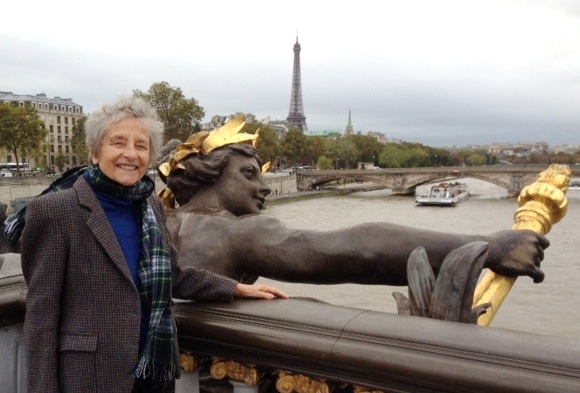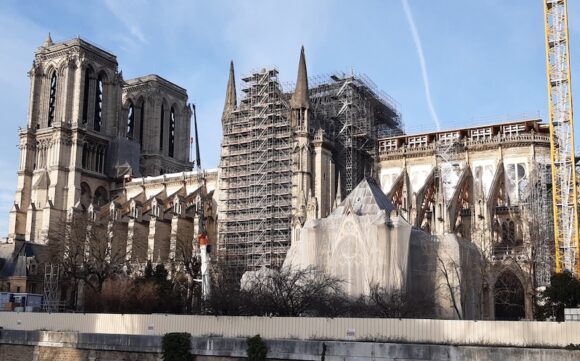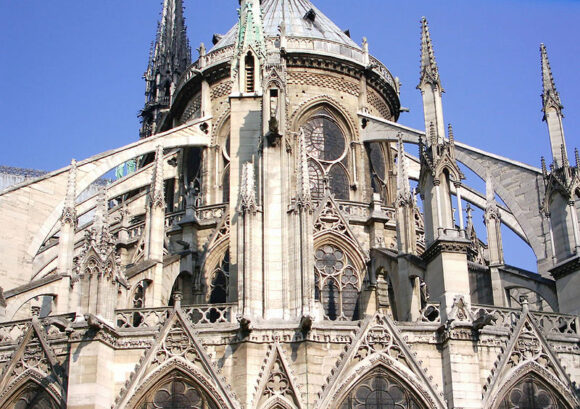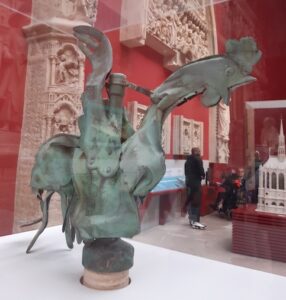
April 15, 2021 was the second anniversary of the fire, which ravaged Notre Dame cathedral in Paris, and also the day when France reached 100,000 deaths from COVID-19. President Emmanuel Macron of France stressed that the reconstruction of the cathedral will be the symbol his country’s rebound from the pandemic.
Before giving the latest update of the most recent restoration process, here is a recap of what has been achieved over the past two years. The scope of the work is enormous.
For a long time, whenever I used to walk around the church prior to the 2019 fire, I had noticed that there was always scaffolding somewhere on the church. It was a reminder for visitors that the cathedral was very old and fragile.
Throughout the centuries, it had suffered many fires and disasters. But the 2019 fire was the most catastrophic of all. It was a miracle that the cathedral survived that last tragedy.
After the fire, with hardly a square inch of the stone building still visible under so much scaffolding, wooden frames, plastic wrapping, tarp covers, and other protective contraptions, it was almost no longer recognizable. It ended up looking like a sick old bird.

The gables and pinnacles at the end of the north and south transepts were in danger of toppling over with the force of the wind. Workers, dangling in the air like alpinists were doing their perilous job of wrapping the carved stones. Hovering over the cathedral cranes and other heavy machinery made the church look as if it was under perfusion.
The stained-glass windows were taken down and replaced by what looked like giant French doors. The collapse of the 19th century spire over the nave had left an enormous gaping hole at the crossing of the transept. Water – regardless of whether it is rain or the power spray used by firefighters – can cause lots of damage. It penetrates the stones, destroying the mortar between them .
The fire obliterated the roof. The lead dripped, spread and left a thick layer of toxic dust everywhere. For months, no one could go inside the cathedral because of the danger from the lead dust and also from the debris falling from the broken vault. A lonely robot, directed by remote control, was able to clear up the charred remains.
The organ and the three rose windows were thankfully preserved, but they will, however, require lengthy restoration. The 7,800 pipes of the largest organ in the word have been pulled apart and so have been all the stained-glass pieces.

It is particularly comforting to know that the Rose Window at the south end of the transept is intact. Given the light of the sun throughout the day, it is the Rose Window, which gives the cathedral its beautiful warm glow. Notre Dame would not be the same without the scenes of the triumphant Christ depicted through that magnificent window. In 1250, Louis IX, or Saint Louis, donated it after the end of the second crusade.
The April 15, 2019 fire left the cathedral in danger of collapse — in fact, it was a touch-and-go situation. The most urgent step was to consolidate the structure
A gothic cathedral is like a house of cards:- if one side weakens, the whole thing collapses. Because of its daring height and the fact that the outside walls are weakened by several tiers of windows, the structure is fragile.
The medieval master carpenters were real geniuses when they designed the 28 flying buttresses to reinforce the strength of the walls. An arch or beam extends from the walls of the church to a pier against the lateral forces arising from the roof and pushes the walls outwards.
Ken Follett in his 2002 book, The Pillars of the Earth, wrote a gripping story of the 12th century monks attempting to do something never done before, failing many times and starting all over again.
The earliest buttresses of Notre Dame date from the 12th century. They are massive and fairly close to the main structure. Later, during the flamboyant gothic period in the 14th century, the spans of the flying buttresses are longer and more decorated.
The first phase of the restoration — preservation and protection — lasted 15 months. President Macron appointed General Jean Louis Georgelin, former chief of staff under President Sarkozy, to supervise the work.

The 28 damaged buttresses were reinforced by fitting custom-made wooden “centering frames” under each one of them. Each one of the buttresses had different dimensions, hence the fitting required utmost precision.
Then started the most difficult and dangerous operation: dismantling the scaffolding, which had been erected in May 2018 to repair the crumbling spire created by 19th century architect Eugene Viollet-le-Duc.
That scaffolding had melted, creating an ugly- and mean-looking black mass of 40,000 metal pieces glued together. Rope access workers (called cordists in French) had to pick the pieces by hand one by one, hanging from ropes high in the air. Sensors were placed under that unstable mass.
At one point the alarm sounded. Everybody fled. To disentangle that mass was like playing a giant pick-up sticks game, which involves removing sticks without disturbing the rest of the pile.
Twice the restoration work on the cathedral was interrupted: first when the scare caused by the lead contamination forced all activities to stop. Workers had to wear white haz-mat suits with masks connected to supplies of filtered air. They looked as clumsy as moon walkers.
Subsequently, the lock-down caused by the Coronavirus pandemic in March 2020 shut down operations for three months.
Five days before the fire, as a result of a near-miracle, the 10 ft. tall copper statues of the apostles and evangelists, climbing up the bases of the spire were air-lifted for restoration. Parisians enjoyed watching the ballet in the sky.
The statues are being restored in two workshops located near Perigueux. It takes four month to restore one statue. Pending the completion of the cathedral, all these art works will be exhibited at the museum of architecture on Place du Trocadero.

The rooster, pictured left, which used to sit at the top of the spire, will remain in the museum. A replica will replace it.
Late in June 2020, chief architect Philippe Villeneuve climbed on an inspection tour of the cathedral. He was able to access the top of the vaults, which by then had been cleared of most of the debris.
Villeneuve was pleased to see that the limestone of the vault had resisted the damage caused by the fire itself as well as the water to extinguish the fire. For him, it was a milestone and he declared that the structure was now safe.
The first phase of conservation was over and one could look forward to the restoration to be launched at a later date.
In July 2020 came the decision everybody was waiting for. After months of deliberation and heated discussions between architects, historians and restoration professionals across the globe about how the future Notre Dame would look, a consensus was reached.
Based on a 300-page paper presented by Villeneuve and with the support of the public opinion, it was decided that the cathedral would be returned to its original appearance:- a spire identical to 1859 Viollet-le-Duc’s creation; a lead roof; and a wooden framework to support the roof.
A large part of the restoration work will be carried out using the methods of 13th century builders. Fortunately this type of savoir faire is kept alive in France thanks to a guild of crafted artisans, who are trained as Compagnons du Devoir.
All restoration will be done respecting the safeguards established by ICOMOS (the International Council for Monuments and Sites) founded by the Venice Charter of 1964 to protect historic monuments.
In 1991, UNESCO placed Notre Dame and the banks of the Seine within the area considered as part of the world heritage.
Within 24 hours of the fire, pledges to pay for the restoration poured in and reached close to one billion Euros. The two richest men in France raced to be the highest bidder. François Pinault pledged 100 million and refused to accept tax deductions. Bernard Arnault beat him with a sum of 200 million.
Arnault is the head of the LVMH (Louis Vuitton Moët Hennessy) luxury goods and champagne empire. The readers of this area might be interested to know that Antoine, one of the Arnault’s five children, is building a “cottage” in the Fenwick peninsula in Old Saybrook. He is married to Russian super-model Tatyana.

At the two year mark since the fire, it is fitting to give the most recent update on the restoration process of Notre Dame. The task concerns the strengthening of the cathedral’s vault and the preparation of the future wooden framework, which will support the roof.
The scope of this phase to secure the building should be completed by next summer. It is just gigantic.
Most of the cathedral’s interior is now encased in metal scaffolding. An umbrella-like tarp has been installed above the gaping hole, where the spire once stood, for protection against the rain.
The vaults connecting the crossing of the transept were covered with platforms to enable rope-access workers to complete their job of removing the last fallen debris. This operation is still ongoing.
Most of those debris — stone, metal, glass — have been cleared up, analyzed, and used toward the creation of a 3D model, which is a replica of the original architecture and guiding the restorers in their mission.
Wooden scaffolding is being installed to stabilize the fragile areas of the cathedral’s vault, particularly the vaults adjacent to the crossing of the transept. Stonemasons apply plaster to the gaps and the exposed ends of the stones. They reinforce the most damaged areas with fiberglass.
The next step will be the insertion “of half-hangers” (also called “centring frames”) under the six-rib vaults in the choir, the north transept and the nave. Note that the spire crashed toward the West, onto the nave.
Above the vault and under the roof, other major work is in progress. The reconstruction of the 12-14th century wooden framework, called “the forest” is being prepared. Made-to-measure “half-hangers” and large-size triangular frames are being wedged under the roof to support it.
One thousand of the best oak trees have already been picked out in several French forests. A CNRS (National Center for Scientific Research) study of the use of timber led to surprising conclusions. Those conclusions differ from what one often reads in non-scientific publications.
The 13th century trees were much younger and smaller than often stated: 60 years, 39 ft. in height, and 12 ins. in diameter. Furthermore, the trees were not left to dry for 18 months but were used while still green, after being felled.
From the top of the cathedral, President Macron, accompanied by Paris Mayor Anne Hidalgo and Minister of Culture Roselyne Bachelot expressed huge thanks to the hundreds of people involved in the restoration: carpenters, scaffolders, rope access technicians, crane operators, master glassmakers, restorers, stonemasons, archaeologists, researchers and donors.
Macron reiterated his vision of the cathedral reopening to worship by 2024 in time for the Olympic games, while acknowledging the fact that the complete restoration will probably take several years longer.
A glimmer of hope is much needed for the weary French population. The latest curfew at 6 p.m., which applied to the whole country, should be lifted in early May, with café and restaurant terraces reopening by mid-May — that should really boost morale!